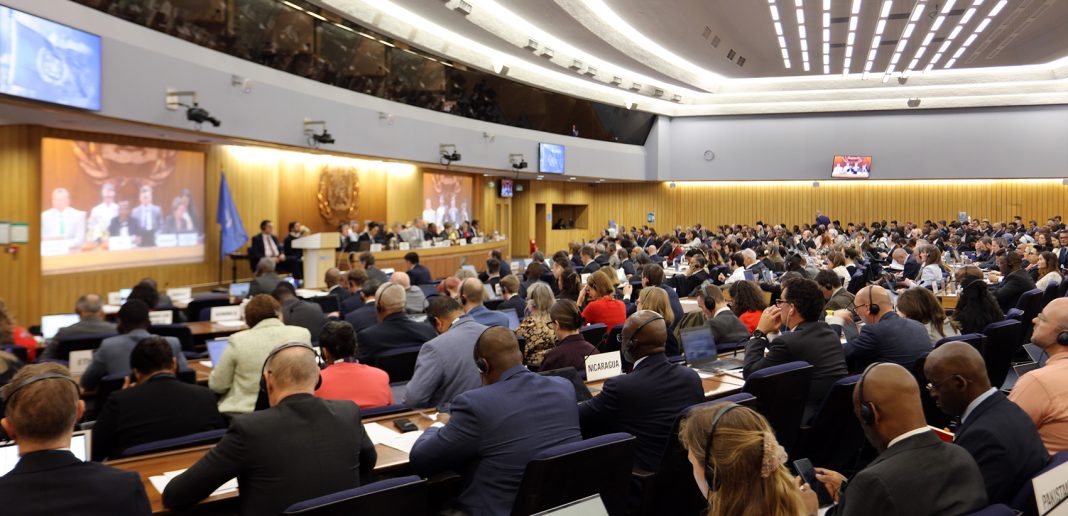The International Maritime Organization (IMO) has taken a significant stride towards a legally binding framework for reducing greenhouse gas (GHG) emissions from international shipping, with the ambitious goal of achieving net-zero emissions by 2050.
In a world first, for an entire industry sector, the IMO’s newly approved Net-Zero Framework uniquely integrates mandatory emissions limits with a global GHG pricing mechanism.
The draft regulations, endorsed by the Marine Environment Protection Committee (MEPC 83) during its session from April 7-11, 2025, encompass a novel fuel standard for ships and a comprehensive global pricing mechanism for emissions.
These groundbreaking measures are slated for formal adoption in October 2025 and are expected to enter into force in 2027. They will apply mandatorily to large ocean-going vessels exceeding 5,000 gross tonnes, which account for approximately 85% of the total CO2 emissions from international shipping.
Closing the MEPC 83 meeting in Addlestone, England, IMO Secretary-General Mr. Arsenio Dominguez lauded the collaborative spirit and dedication exhibited by Member States. He stated, “The approval of these draft amendments to MARPOL Annex VI, mandating the IMO Net-Zero Framework, marks another crucial step in our collective endeavor to tackle climate change and modernize shipping. It unequivocally demonstrates the IMO’s commitment to delivering on its promises.”
He further emphasized, “Moving forward, it is vital that we continue to work together, engaging in open dialogue and actively listening to each other, to establish the necessary conditions for successful adoption.”
Key Components of the IMO Net-Zero Framework:
- The IMO Net-Zero Framework will be incorporated into a new Chapter 5 of Annex VI (Prevention of air pollution from ships) of the International Convention for the Prevention of Pollution from Ships (MARPOL).
- MARPOL Annex VI currently boasts 108 Parties, representing 97% of the global merchant shipping fleet by tonnage, and already includes mandatory energy efficiency requirements for ships.
- The overarching objective is to realize the climate targets outlined in the 2023 IMO Strategy on the Reduction of GHG Emissions from Ships, accelerate the uptake of zero and near-zero GHG fuels, technologies, and energy sources, and facilitate a just and equitable transition.
The draft regulations will mandate that ships comply with:
- Global Fuel Standard: Ships will be required to progressively reduce their annual Greenhouse Gas Fuel Intensity (GFI) – the amount of GHG emitted per unit of energy consumed. This calculation will utilize a well-to-wake approach, considering emissions across the entire fuel lifecycle.
- Global Economic Measure: Vessels exceeding the established GFI thresholds will need to acquire “remedial units” to offset their excess emissions. Conversely, ships utilizing zero or near-zero GHG technologies will be eligible for financial incentives.
- Ensuring Compliance:
- The framework will implement a two-tiered system for GHG Fuel Intensity targets: a Base Target and a more stringent Direct Compliance Target, the achievement of which will allow ships to earn “surplus units.”
Ships exceeding the set emissions thresholds will have several options to balance their emissions deficit:
- Transferring surplus units from other vessels.
- Utilizing previously banked surplus units.
- Acquiring remedial units through contributions to the IMO Net-Zero Fund.
- The IMO Net-Zero Fund:
The IMO Net-Zero Fund will be established to collect revenue from the emissions pricing mechanism. These funds will then be strategically allocated to:
- Provide financial rewards to low-emission ships.
- Support innovation, research, infrastructure development, and just transition initiatives in developing countries.
- Fund training, technology transfer, and capacity building to support the IMO GHG Strategy.
- Mitigate potential negative impacts on vulnerable States, including Small Island Developing States and Least Developed Countries.
Next Steps:
Following the approval of the draft amendments to MARPOL Annex VI, the documents will be formally circulated to IMO Member States. The subsequent key milestones include:
- October 2025 (MEPC/ES.2): Formal adoption of the amendments during an extraordinary session of the Marine Environment Protection Committee.
- Spring 2026 (MEPC 84): Approval of detailed implementation guidelines.
- 2027: Expected entry into force of the regulations, 16 months after adoption, by MARPOL articles.
Other Outcomes of MEPC 83:
Beyond the landmark Net-Zero Framework, MEPC 83 addressed a range of critical issues related to the protection of the marine environment from shipping activities, resulting in the following key outcomes:
- Adoption of the 2025 Action Plan to combat marine plastic litter.
- Progress in the review of the Ballast Water Management Convention.
- Approval of a proposal to designate the North-East Atlantic as an Emission Control Area and agreement in principle to designate two new Particularly Sensitive Sea Areas off South America’s Pacific coast.
- Approval of the draft Work plan on the development of a regulatory framework for the use of Onboard Carbon Capture Storage systems (OCCS).
- Approval of draft amendments to regulation 27 of MARPOL Annex VI regarding the accessibility of the IMO Data Collection System.
- Adoption of amendments to the 2021 Guidelines on the operational carbon intensity reduction factors relative to reference lines (CII reduction factors guidelines, G3).
- Approval of a new output to develop a legally binding framework on biofouling management to prevent the spread of harmful invasive aquatic species.




